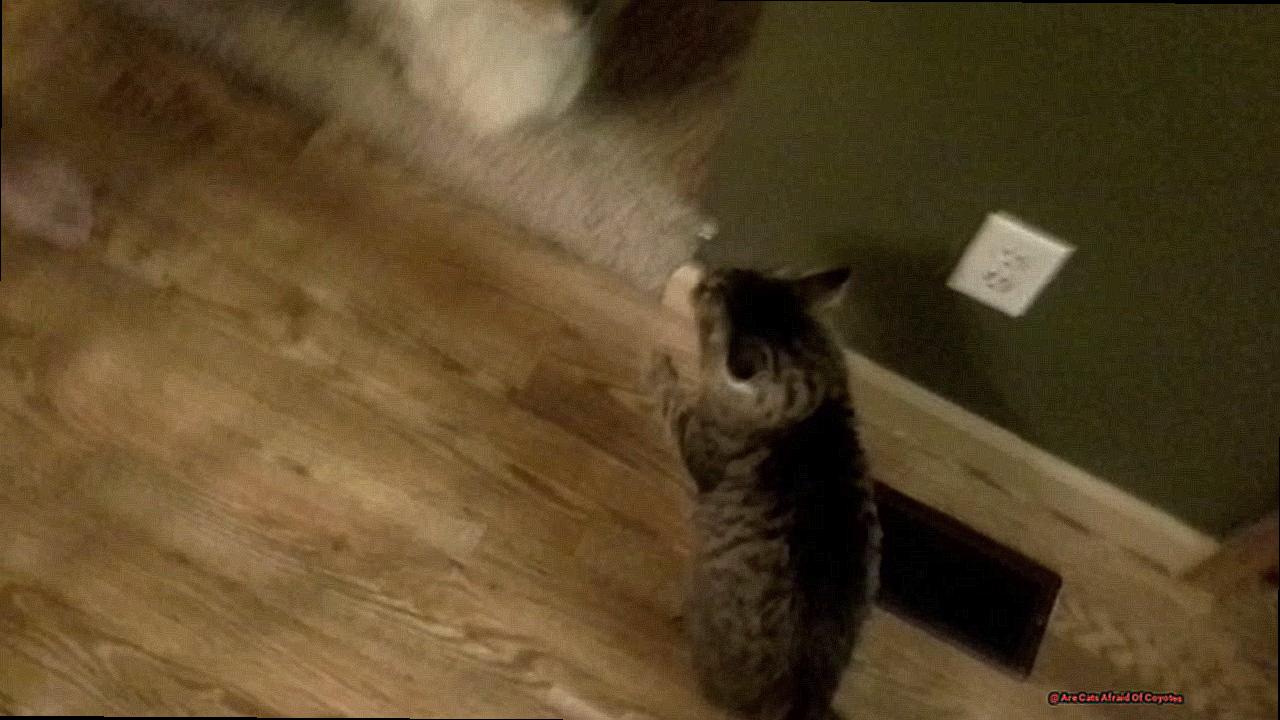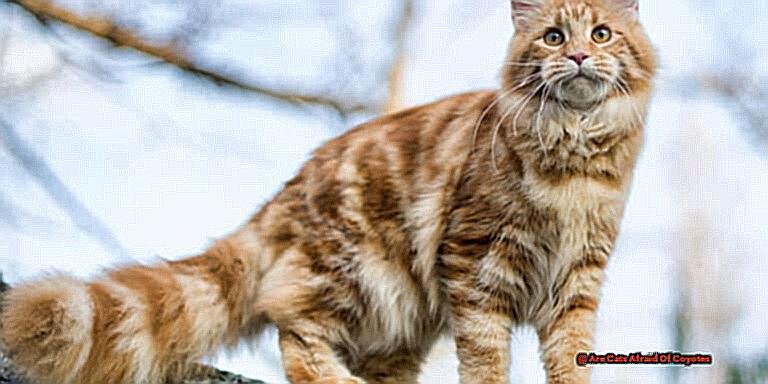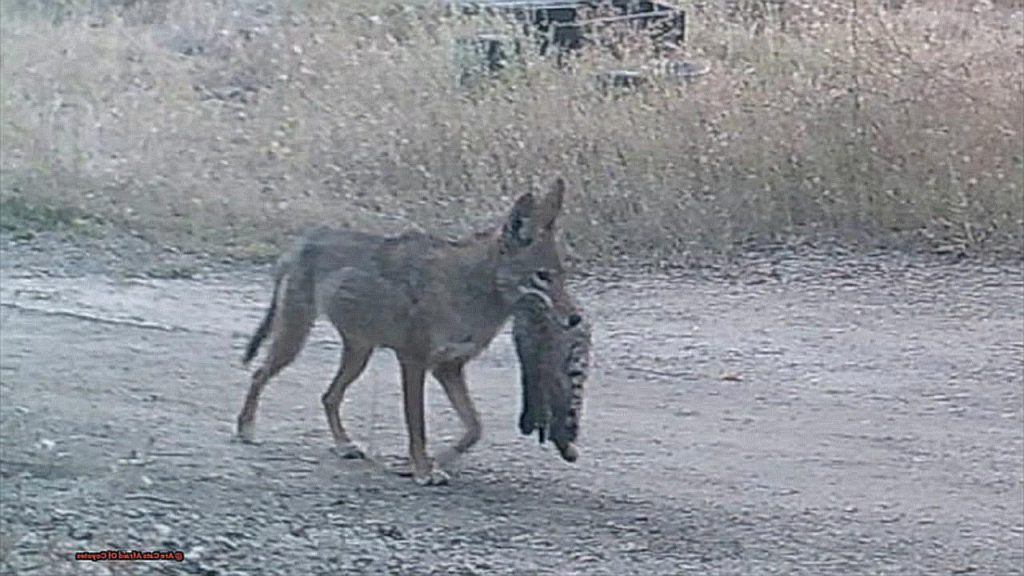Imagine a serene evening in your backyard, the sun slowly slipping below the horizon and painting the grass with a warm glow.
Suddenly, a rustling in the bushes interrupts the peaceful scene. Your heart races as you wonder what could be lurking in the shadows.
And then, out of nowhere, a sleek and agile creature emerges – a coyote. But to your surprise, there’s another figure darting around fearlessly – your beloved feline companion.
Let’s delve into this intriguing question and discover whether our fearless feline friends truly have no qualms about these wild predators.
Are Cats Afraid Of Coyotes?
Contents
When we think of cats and coyotes, the common belief is that they are natural enemies. After all, both are predators and compete for similar prey in the wild. But have you ever wondered if cats are actually afraid of coyotes?
As a cat owner, I have always been curious about this question. So, I did some research to find out the truth behind this myth. And as it turns out, cats do have a fear of coyotes. Let’s dive into the reasons why.
The Relationship Between Cats and Coyotes

Before we can understand why cats are afraid of coyotes, it’s important to understand their natural behaviors and habitats. Cats are solitary hunters who are territorial by nature. They are smaller in size and less dominant compared to coyotes.
On the other hand, coyotes are larger and more dominant predators. They also have a strong sense of territory and may view cats as competition for resources.
Do Cats Perceive Coyotes as a Threat?
Numerous studies have shown that cats have a strong sense of self-preservation and are cautious of unfamiliar animals. This instinct is ingrained in their DNA from their wild ancestors who had to constantly defend themselves against larger predators.
In addition, cats also have a heightened sense of smell and can detect predators from a distance. The scent of a coyote can easily put a cat on high alert and trigger their fear response.
Factors That Influence a Cat’s Reaction to Coyotes
Various factors can affect how a cat reacts to the presence of a coyote. Age and experience play a significant role – kittens may be more fearful of unfamiliar animals while older cats may have encountered coyotes before and know to be cautious.
A cat’s territory also plays a crucial role in their reaction to coyotes. They may be less fearful if they encounter a coyote in their own space as they feel more in control and protected. Breed also plays a role, as some breeds, like Bengal cats, have a stronger instinct to defend themselves against predators.

Signs That Indicate a Cat is Afraid of Coyotes
So, how do you know if your cat is afraid of coyotes? Some signs to look out for include hiding or avoiding areas where a coyote has been spotted, increased vocalization or aggressive behavior towards the coyote, and marking territory with urine or scratching to assert dominance.
Domestication and Its Effects on a Cat’s Ability to Defend Against Predators
Thousands of years ago, cats were domesticated by the ancient Egyptians for their hunting abilities. However, as they became more and more domesticated, their natural instincts for survival began to shift. Unlike their wild counterparts, domesticated cats no longer possess the same level of awareness and caution when it comes to potential dangers.
They have grown accustomed to a life of leisure, relying on their owners for food and shelter.
Physical Limitations
In addition to changes in their instincts, domestication has also led to physical limitations for cats. Living indoors has made them less physically fit and agile compared to their wild counterparts, making it difficult for them to defend against larger predators like coyotes.
Without the need to hunt for food, domesticated cats also lack the same level of hunting and survival skills as their wild counterparts.
Changes in Behavior
The domestication process has also had an impact on a cat’s behavior. Domesticated cats tend to be more docile and submissive, making them an easier target for predators like coyotes. This is especially true for indoor cats who may not have had enough exposure to other animals or outdoor environments.
Tips for Protecting Your Cat
So what can you do as a responsible pet owner to keep your furry friend safe from potential predators? Here are some tips:
- Keep your cat indoors: The best way to protect your cat from predators is by keeping them indoors. This not only prevents them from encountering larger animals but also protects them from potential dangers such as cars and diseases.
- Supervise outdoor time: If you do allow your cat to spend time outdoors, make sure to supervise them and keep an eye out for any potential predators in the area.
- Provide a safe outdoor space: If you have a fenced yard or outdoor enclosure, this can be a great way to give your cat some outdoor time while keeping them safe from predators.
The Role of Coyote Howls in Triggering a Cat’s Fear Response
First and foremost, let’s understand the science behind this fear response. Cats are natural predators, but they are also prey to other animals, including coyotes. This is due to centuries of coexisting with these wild canines, who are known for preying on smaller animals like cats. Therefore, cats have evolved to instinctively recognize and fear the sound of a coyote howl as a potential threat.
In the wild, cats would hear the howls of coyotes as a warning sign to stay hidden or flee to safety. This instinctual fear response has carried over into domesticated cats as well. Even though they may not encounter coyotes in their everyday lives, their instincts are still intact, and they will react with fear when they hear a coyote howl.
So why is this important for cat owners? As responsible pet parents, it is our duty to keep our furry companions safe and secure. Understanding that coyote howls trigger fear in cats can help us take necessary precautions to protect them. Keeping your cat indoors, supervising outdoor time, and providing a secure outdoor space are all crucial steps in ensuring your cat’s safety from potential coyote attacks.
Furthermore, it is essential to keep in mind that coyotes are adaptable and can thrive in urban areas as well. This means that even if you live in a city or suburban area, your cat may still be at risk of encountering a coyote. By being aware of this potential danger, you can take proactive measures to keep your cat safe.
Heightened Senses: How a Cat’s Sense of Smell Can Detect Danger from Coyotes
As a cat owner, it’s important to understand the incredible abilities of your feline friend. We all know that cats have a heightened sense of smell, but did you know that they can also use this sense to detect danger? Specifically, the distinct odor of coyotes.
With approximately 200 million scent receptors in their noses, cats have a super-powered sense of smell that far surpasses our own. This allows them to pick up on even the slightest changes in their environment, including the presence of predators like coyotes.
But the nose isn’t the only tool in a cat’s arsenal. They also have a specialized organ called the vomeronasal organ, located in the roof of their mouth, which helps them gather even more detailed information about their surroundings. This organ is responsible for detecting pheromones and other chemical signals, making it an essential part of a cat’s heightened senses.
When it comes to coyotes, their distinct musk glands give off a strong odor that cats can detect from far distances. This is why you may notice your cat becoming more alert and cautious when they pick up on the scent of a coyote. It’s their natural instinct to recognize these predators as potential threats to their safety.
But it’s not just the scent that cats can pick up on. Studies have shown that they can differentiate between different predators and will react differently depending on the level of danger they perceive. So while they may simply avoid an area if they smell a smaller predator like a raccoon or opossum, they will become more vigilant and may even display aggressive behaviors if they smell the scent of a larger predator like a coyote.
In addition to their acute sense of smell, cats also have incredible hearing abilities. They can pick up on subtle sounds that humans may not even notice, such as the rustling of leaves or snapping of twigs, which could indicate the presence of a nearby coyote.
But it’s not just their senses that allow cats to detect coyotes. They are also highly attuned to body language and vocalizations, which can signal danger. For example, if your cat sees a coyote approaching, they may freeze and flatten their ears, indicating that they are aware of the potential threat.
Past Experiences and Their Impact on a Cat’s Fear of Coyotes
As cat owners, we all want to keep our feline friends safe from harm. And one of the biggest threats to our outdoor cats is the presence of coyotes. But have you ever wondered why some cats seem to be more fearful of coyotes than others? Well, it turns out that a cat’s past experiences play a significant role in their level of fear towards these predators.
It’s no surprise that cats, being natural predators themselves, have a built-in instinct to fear other predators in their environment. This instinct is passed down from their wild ancestors and helps them protect themselves from potential threats. But what about cats who have had previous encounters with coyotes? Their fear level may be heightened due to a direct confrontation or simply observing a coyote from a distance.
But it’s not just direct encounters that can contribute to a cat’s fear of coyotes. Negative experiences with other predators that are similar in size and appearance, such as wolves or large dogs, can also play a role in their fear towards coyotes. This is because they may associate the appearance and behavior of these animals with past traumatic experiences.
On the other hand, positive experiences with other animals can actually lessen a cat’s fear towards coyotes. If a cat has had pleasant interactions with other animals, they may see coyotes as just another animal in their environment instead of a potential threat.
But it’s not just past experiences that can shape a cat’s fear towards coyotes. Learned behavior from other cats can also play a significant role. Cats are highly observant creatures and if they see another feline exhibiting fear towards a coyote, they may mimic that behavior and become afraid themselves.
Age also plays a factor in a cat’s fear level towards coyotes. Older cats who have had more life experiences may be more cautious and fearful of potential threats compared to younger cats who are still learning about the world around them. And it’s not just domesticated cats who can develop a fear of coyotes. Feral or stray cats, who are constantly exposed to danger and predators, may have a heightened sense of fear for survival purposes.
Lastly, the location and environment in which a cat lives can greatly influence their fear of coyotes. Cats living in urban areas where coyote sightings are rare may not have as much fear towards them compared to cats living in rural areas where coyotes are more prevalent.
How Cats Avoid Areas Where They Know Coyotes are Present Due to Their Innate Survival Mechanisms
If you’re a cat owner, you may have noticed that your feline friend has an uncanny ability to avoid potential danger. Whether it’s a loud noise or an unfamiliar animal, cats seem to have a sixth sense when it comes to sensing danger. And when it comes to coyotes, this survival mechanism is taken to a whole new level.
Here’s how cats utilize their innate survival mechanisms to avoid areas where they know coyotes are present, keeping themselves safe from potential harm.
Sense of Smell
Cats have an incredibly keen sense of smell, and it plays a crucial role in their survival. This heightened sense allows them to detect the presence of predators like coyotes in their environment. In fact, studies have shown that cats can distinguish between different scents and even identify specific individuals by their smell.
So when a cat catches a whiff of a coyote in the area, they will instinctively steer clear of that location. This behavior is not only seen in domestic cats but also in their wild counterparts like African and European wildcats.
Excellent Hearing
In addition to their keen sense of smell, cats also have excellent hearing. They can pick up on sounds that humans can’t even hear, making them aware of any potential dangers in their surroundings. When a cat hears the howl or yip of a coyote, they become alert and cautious, avoiding the area where the sound is coming from.
Survival Instincts
Cats are natural-born hunters and have evolved over thousands of years to survive in the wild. As a result, they have developed strong instincts to keep themselves safe from predators. This includes avoiding areas where they know coyotes are present.
Cats know that being in close proximity to a predator puts them at risk, so they will do whatever it takes to stay away from these areas. This explains why some cats may refuse to go outside or become anxious when they sense the presence of a coyote nearby – it’s their natural survival instincts kicking in.
Varied Responses: Different Reactions Cats May Have When Confronted with Coyotes
If you’re a cat owner, the thought of your beloved feline encountering a wild coyote may send shivers down your spine. And rightfully so – these cunning predators can pose a threat to our furry friends. But have you ever wondered how your cat might react in such a situation? Let’s take a closer look at the various responses cats may have when confronted with coyotes.
Fear and Flight
Just like us, cats have a natural instinct to avoid danger. So it’s no surprise that when faced with a coyote, some of our feline friends may choose to run away as fast as their little paws can carry them. This reaction is especially common in indoor cats who have little to no experience with predators and are not equipped with the skills to defend themselves.
Fight or Flight
On the other hand, some cats may choose to stand their ground and defend themselves against a coyote. This is more likely to occur in outdoor cats who are accustomed to defending their territory against other animals and perceive the coyote as a threat. However, this brave response can also put your cat in harm’s way, so it’s important to keep an eye on them if they tend to be confrontational.
Past Experiences Matter
According to research, cats who have had previous encounters with coyotes may show more fear and avoidance towards them. This means that past experiences can greatly influence a cat’s response to a coyote. If your cat has had negative experiences with these predators before, they may be more likely to exhibit fear and try to flee.
Age and Health Play a Role
It’s important for cat owners to consider their pet’s age and health when it comes to their response to coyotes. Older or sick cats may not have the energy or strength to fight back and instead choose to flee or hide. On the other hand, younger and more curious cats may be unaware of the danger posed by coyotes and may be more vulnerable to attacks.
Feral Cats vs. Domesticated Cats
It’s worth noting that feral cats, who have had minimal human interactions, may not show any fear towards coyotes at all. This is because they have learned to survive in harsh environments and may see coyotes as just another predator in their surroundings. Domesticated cats, on the other hand, may not have the same level of survival skills and instincts.
Conclusion
In conclusion, the notion that cats are fearless creatures and not afraid of anything has been proven wrong when it comes to coyotes. Despite their reputation as fierce hunters, cats do have a natural fear of these wild predators. This fear is ingrained in their survival instincts, previous encounters with coyotes, and their competition for resources.
From their keen senses and innate instincts to their learned behavior and maturity level, there are multiple factors that influence a cat’s reaction to a coyote. While some may choose to flee or defend themselves, it is our responsibility as pet owners to take necessary precautions to keep our furry companions safe.
Understanding the dynamics between cats and coyotes can help us protect our beloved pets from potential harm. Whether it means keeping them indoors, supervising outdoor time, or providing a secure outdoor space, these simple measures can make all the difference in ensuring the safety of our feline friends.






